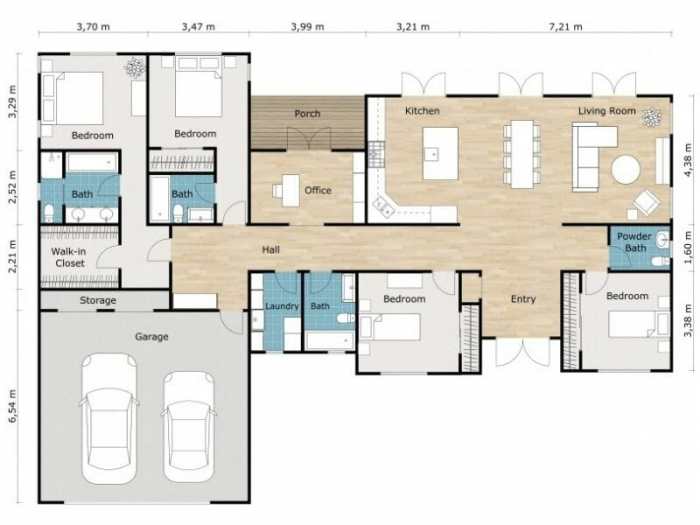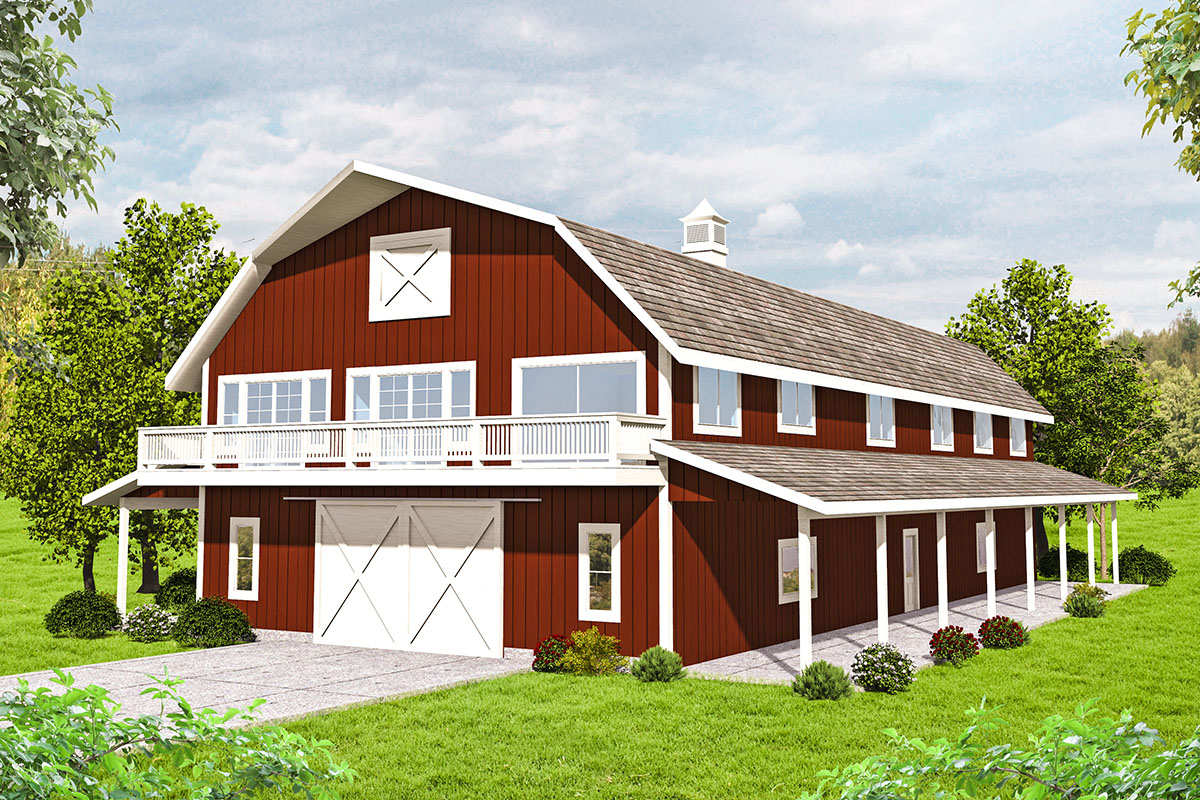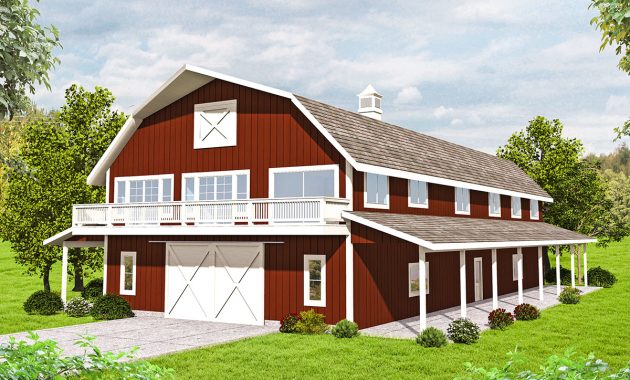Exploring Barn Home Floor Plans: Barn Home Design Plans

Barn home design plans – Barn homes offer a unique blend of rustic charm and modern functionality. Their adaptable nature allows for a wide variety of floor plan designs, catering to diverse lifestyles and family sizes. Choosing the right floor plan is crucial for maximizing space, promoting efficient traffic flow, and creating a comfortable living environment. This section will explore common barn home floor plans, highlighting their advantages and disadvantages to aid in the design process.
Understanding the different floor plan layouts available for barn homes is essential in the design process. Each layout presents unique opportunities and challenges concerning space utilization, traffic flow, and overall livability. Careful consideration of these factors will result in a home that is both aesthetically pleasing and highly functional.
Common Barn Home Floor Plan Layouts
Several common floor plan layouts are frequently used in barn home designs. Each offers distinct advantages and disadvantages that should be carefully weighed against individual needs and preferences. The following bullet points summarize the characteristics of each.
- Open Concept: This layout features a large, undivided space encompassing the kitchen, living, and dining areas. Advantages: Creates a spacious and airy feel, ideal for entertaining. Disadvantages: Can feel less private, noise can easily carry throughout the space, and may not suit everyone’s preference for defined rooms.
- Split-Level: This design utilizes different floor levels to separate living areas. Advantages: Offers distinct zones for different activities, providing a sense of privacy and separation. Disadvantages: Can be challenging for individuals with mobility issues, and may require more extensive stairways.
- Traditional: This layout incorporates distinct rooms for each function – separate kitchen, living room, dining room, and bedrooms. Advantages: Provides clear separation between areas, promoting privacy and quiet. Disadvantages: Can feel less spacious than open-concept designs, may not be suitable for smaller lots.
- Loft Style: This design features a raised sleeping area or loft, often overlooking the main living space below. Advantages: Maximizes vertical space, creates a unique architectural feature. Disadvantages: May not be suitable for families with young children due to safety concerns, and the loft area might be less private.
Considerations for Functional and Spacious Floor Plans
Designing a functional and spacious barn home floor plan requires careful consideration of several key factors. Prioritizing efficient traffic flow and maximizing natural light are crucial for creating a comfortable and inviting living space.
Traffic Flow: A well-designed floor plan minimizes unnecessary movement between rooms. Consider the placement of hallways, doorways, and common areas to ensure easy navigation throughout the house. Avoid creating bottlenecks or cramped hallways. Strategic placement of rooms, such as placing the kitchen near the dining area, can improve efficiency.
Natural Light: Barn homes often feature large windows and open spaces, making it easy to maximize natural light. Design the floor plan to take advantage of this by strategically placing windows to illuminate key areas like the living room and kitchen. Consider the orientation of the house to maximize sunlight throughout the day. Skylights can also be incorporated to enhance natural light in areas where windows might be limited.
Sample Two-Bedroom Barn Home Floor Plan
This text-based description Artikels a simple floor plan for a two-bedroom barn home. Dimensions are approximate and can be adjusted based on specific needs and site constraints.
The main floor features an open-concept kitchen (12ft x 14ft) and living room (16ft x 20ft) area with large windows facing south. A hallway leads to two bedrooms (each 12ft x 10ft) and a bathroom (8ft x 6ft). A laundry area (6ft x 4ft) is located near the back entrance. A staircase leads to a loft area that could be used as an office or additional sleeping space (14ft x 10ft).
Material Selection and Construction

Choosing the right materials is crucial for building a durable and aesthetically pleasing barn home. The selection process should consider factors such as budget, desired aesthetic, regional climate, and environmental impact. This section will explore popular building materials, their advantages and disadvantages, and sustainable options.
Popular Building Materials for Barn Homes
The choice of building materials significantly impacts the overall cost, longevity, and aesthetic appeal of a barn home. Several materials are commonly employed, each with its own set of pros and cons.
| Material | Pros | Cons | Cost-Effectiveness |
|---|---|---|---|
| Wood | Aesthetically pleasing, readily available, relatively easy to work with, good insulation properties. | Susceptible to rot, insect infestation, and fire damage; requires regular maintenance; can be expensive depending on the type of wood. | Moderate to High (depending on wood type and availability) |
| Metal (Steel, Corrugated) | Durable, low maintenance, fire-resistant, long lifespan, energy-efficient (can reflect heat). | Can be susceptible to dents and scratches; may require specialized tools and expertise for installation; can be prone to rusting without proper protection; may not provide the same level of insulation as wood without added measures. | Moderate to High (depending on metal type and complexity of design) |
| Stone (Brick, Stone Veneer) | Durable, visually striking, excellent insulation, fire-resistant, long lifespan. | Can be expensive, labor-intensive to install, requires skilled labor; may not be suitable for all climates or architectural styles; heavy, potentially requiring a stronger foundation. | High |
| Concrete | Durable, fire-resistant, pest-resistant, low maintenance. | Can be expensive, labor-intensive to pour and finish; requires specialized equipment; can be visually unappealing unless finished properly; may not be suitable for all climates or architectural styles; has a large carbon footprint. | High |
Sustainable and Eco-Friendly Material Options, Barn home design plans
Increasingly, homeowners are prioritizing sustainable and eco-friendly materials in barn home construction. These options minimize environmental impact and contribute to a greener footprint.
Examples of sustainable materials include reclaimed wood (giving old lumber a new life, reducing landfill waste and embodied carbon), bamboo (a rapidly renewable resource with excellent strength-to-weight ratio), straw bales (an excellent natural insulator), and recycled metal. The use of locally sourced materials also reduces transportation emissions, further enhancing the environmental benefits. Properly managed forests can also provide sustainably harvested lumber, minimizing the negative environmental impacts of deforestation.
Cost-Effectiveness of Different Building Materials
The cost of building materials varies significantly. While wood may seem initially less expensive than stone or metal, the long-term maintenance costs associated with wood can offset the initial savings. Metal, while initially more expensive than some options, may offer a longer lifespan, reducing long-term replacement costs. Stone and concrete are generally the most expensive upfront but provide exceptional durability.
The overall cost-effectiveness of each material should be carefully assessed considering initial costs, maintenance requirements, lifespan, and energy efficiency. A detailed cost analysis, factoring in labor costs and potential long-term savings from energy efficiency, is crucial for making an informed decision. For example, a metal roof, while initially expensive, may significantly reduce long-term energy costs by reflecting solar heat, potentially saving money on cooling bills compared to a wood shingle roof.
Incorporating Modern Amenities

Integrating modern amenities into a barn home design presents a unique opportunity to blend rustic charm with contemporary convenience. The key lies in careful selection and discreet placement of technology, ensuring it complements rather than clashes with the home’s character. A successful integration respects the original aesthetic while enhancing comfort and functionality.Modern amenities needn’t detract from a barn home’s rustic appeal.
Instead, thoughtful design can subtly incorporate these advancements, enhancing the overall living experience without sacrificing the desired aesthetic. For instance, smart home technology can be integrated seamlessly through the use of discreetly placed control panels or voice-activated systems. Energy-efficient appliances can be chosen to match the home’s style, maintaining a cohesive look. The challenge lies in finding the right balance between functionality and visual harmony.
Smart Home Features for Barn Homes
The selection of smart home features should prioritize practicality and seamless integration with the rustic environment. Overly flashy or technologically advanced systems might disrupt the desired aesthetic. The focus should be on features that enhance comfort, security, and energy efficiency without drawing undue attention.
- Smart Lighting: Dimmable LED lighting controlled via a central hub or voice commands allows for customized ambiance, enhancing the cozy atmosphere of a barn home. Imagine adjusting the lighting levels to create a warm, inviting glow in the evenings, or setting automated schedules for energy efficiency.
- Smart Thermostat: A programmable thermostat ensures optimal temperature control, minimizing energy waste and contributing to cost savings. This is especially beneficial in a barn home, which may experience greater temperature fluctuations than conventionally constructed homes. The system can be programmed to adjust the temperature based on occupancy and time of day, further maximizing efficiency.
- Security System: A comprehensive security system with smart features such as motion detectors, door/window sensors, and remote monitoring provides peace of mind. The system can be discreetly integrated into the barn home’s structure, maintaining its rustic appearance while ensuring safety and security. Remote access allows for monitoring and control from anywhere.
- Smart Appliances: Energy-efficient appliances, such as a smart refrigerator with inventory tracking or a smart washing machine with optimized water usage, contribute to both sustainability and convenience. These appliances can be chosen to complement the home’s rustic style, avoiding jarring contrasts in appearance.
Frequently Asked Questions
What is the average cost of building a barn home?
The cost varies significantly depending on size, location, materials, and finishes. Expect a wide range, and it’s best to get detailed quotes from builders.
How long does it take to build a barn home?
Construction time depends on the size and complexity of the design, as well as weather conditions and builder availability. Expect several months to a year or more.
What are the zoning regulations for barn homes?
Zoning regulations vary by location. Check with your local authorities to ensure your plans comply with all building codes and restrictions.
Are barn homes energy-efficient?
With proper insulation and energy-efficient appliances and systems, barn homes can be very energy-efficient.

